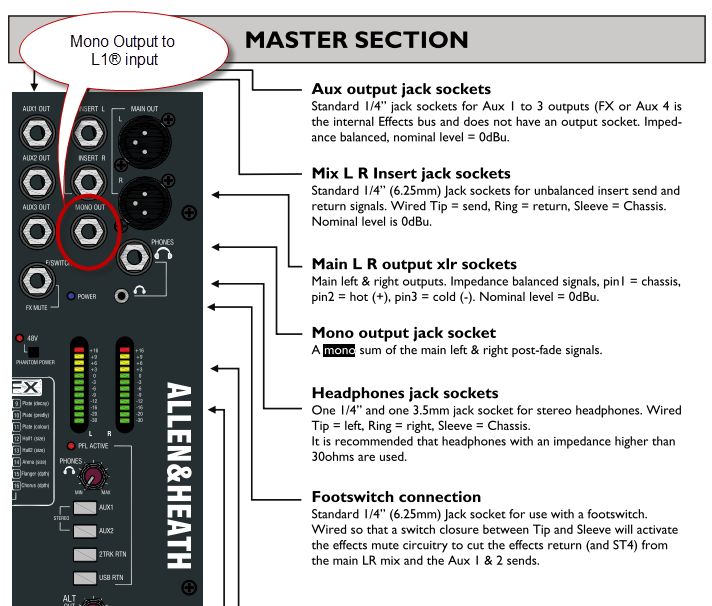Difference between revisions of "Template:Mixer / Allen & Heath ZED Series"
m (New page: <noinclude> Usage: <pre> {{ | Specific Model=ZED-12FX }} </pre> </noinclude> {{Classic icon}}{{Model I icon}} {{Model II icon}} <big>''' Allan Heath {{Specific Model|ZED-12FX}}'''</big> ...) |
m |
||
| (5 intermediate revisions by the same user not shown) | |||
| Line 2: | Line 2: | ||
Usage: | Usage: | ||
<pre> | <pre> | ||
| − | {{ | + | {{Mixer / Allen & Heath ZED Series |
| Specific Model=ZED-12FX | | Specific Model=ZED-12FX | ||
| Line 9: | Line 9: | ||
</noinclude> | </noinclude> | ||
{{Classic icon}}{{Model I icon}} {{Model II icon}} | {{Classic icon}}{{Model I icon}} {{Model II icon}} | ||
| − | <big>''' | + | <big>''' Allen Heath {{{Specific Model|ZED-12FX}}}'''</big> |
== Summary == | == Summary == | ||
| Line 16: | Line 16: | ||
''' {{Use1/4}} ''' | ''' {{Use1/4}} ''' | ||
| + | * The Model II Analog Input. | ||
| + | ** Set the input trim level at "3" and adjust as necessary | ||
| + | ** See [[Model_II#Analog_Input| Model II Analog Input]] for more details. | ||
| + | |||
| + | * Compact Channel 2 | ||
| + | ** Set the ToneMatch® switch to Line Level | ||
| + | ** Set the [[Compact#Channel_2 |Compact Channel 2]] Volume so that with the mixer set at maximum volume levels the Compact Signal/OL light does not turn red. | ||
=== ZED Series Output Section === | === ZED Series Output Section === | ||
| − | [[ | + | [[Image:AllenHeathZED12FXMonoOutput.png]] |
| − | |||
== Outputs == | == Outputs == | ||
| − | === | + | === ¼ Inch with suitable output=== |
| + | for PS1 Powerstand Channel 1 or 2 inputs | ||
| − | {{ | + | {{RunTROrTRSUnbalanced}} |
| − | |||
| − | |||
| − | + | === XLR Balanced +4 === | |
| − | |||
| − | |||
| − | |||
| − | + | {{TooHotForPS1}} | |
| − | |||
| − | |||
| + | The {{PS1}} XLR inputs are designed for microphone level inputs so the +0 dBu output from this mixer is too high for optimal operation - even with the trims levels set to 0. For best results use a [[Pad]] to more closely match the output of the Allen Heath mixer with the inputs of the {{PS1}} | ||
Links: | Links: | ||
Latest revision as of 18:35, 20 February 2014
Usage:
{{Mixer / Allen & Heath ZED Series
| Specific Model=ZED-12FX
}}
Allen Heath ZED-12FX
Summary
Simplest thing that could possibly work.
Use the ¼ inch phone jack (Tip-Sleeve) outputs to
- The PS1 Power Stand (Classic) / Model I Channels 1 or 2 if you want to use the Presets and the R1 Remote Tone and Level Controls
OR - The PS1 Power Stand (Classic) / Model I Channels 3 or 4 if you prefer to leave Channels 1 or 2 open for other inputs. You will have to control Tone and relative Level (between the Channels) at your input source, as you do not have this control over Channels 3 and 4 in the PS1 Power Stand (Classic) / Model I or the R1 Remote.
- The Model II Analog Input.
- Set the input trim level at "3" and adjust as necessary
- See Model II Analog Input for more details.
- Compact Channel 2
- Set the ToneMatch® switch to Line Level
- Set the Compact Channel 2 Volume so that with the mixer set at maximum volume levels the Compact Signal/OL light does not turn red.
ZED Series Output Section
Outputs
¼ Inch with suitable output
for PS1 Powerstand Channel 1 or 2 inputs
You can use TS (Tip Sleeve) unbalanced cables, or TRS (Tip Ring Sleeve) balanced cables, but since the ¼ inch phone connections at the Bose Classic and Model I Power Stand are unbalanced there is no particular benefit using balanced cables.
¼ Inch Tip-Sleeve (unbalanced) to ¼ Inch Tip-Sleeve (unbalanced)
This should work fine.
¼ Inch Tip-Ring-Sleeve (balanced) to ¼ Inch Tip-Sleeve (unbalanced)
This should work fine.
¼ Inch Tip-Ring-Sleeve (balanced) to ¼ Inch Tip-Ring-Sleeve (balanced)
This should also work, but likely no better than a simple ¼ Inch Tip-Sleeve to Tip-Sleeve cable. This is because the ¼ Inch input on the Bose System is Tip-Sleeve (unbalanced) anyway.
XLR Balanced +4
The nominal output of the XLR Balanced Outputs is too high for the XLR inputs on the PS1 Power Stand Channels 1 and 2. If you want to use balanced cables from the Mixer to Channels 1/2 on the L1 Classic or L1 Model I you may need to use a Pad to lower the signal level from the mixer.
{{#Click:Pad|Image:Pad.jpg|Attenuation Pad}}
The PS1 Power Stand (Classic) / Model I XLR inputs are designed for microphone level inputs so the +0 dBu output from this mixer is too high for optimal operation - even with the trims levels set to 0. For best results use a Pad to more closely match the output of the Allen Heath mixer with the inputs of the PS1 Power Stand (Classic) / Model I
Links:




